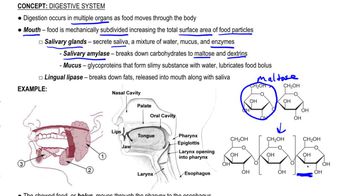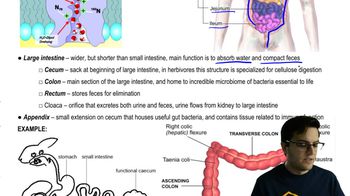Table of contents
- 1. Introduction to Biology2h 42m
- 2. Chemistry3h 40m
- 3. Water1h 26m
- 4. Biomolecules2h 23m
- 5. Cell Components2h 26m
- 6. The Membrane2h 31m
- 7. Energy and Metabolism2h 0m
- 8. Respiration2h 40m
- 9. Photosynthesis2h 49m
- 10. Cell Signaling59m
- 11. Cell Division2h 47m
- 12. Meiosis2h 0m
- 13. Mendelian Genetics4h 44m
- Introduction to Mendel's Experiments7m
- Genotype vs. Phenotype17m
- Punnett Squares13m
- Mendel's Experiments26m
- Mendel's Laws18m
- Monohybrid Crosses19m
- Test Crosses14m
- Dihybrid Crosses20m
- Punnett Square Probability26m
- Incomplete Dominance vs. Codominance20m
- Epistasis7m
- Non-Mendelian Genetics12m
- Pedigrees6m
- Autosomal Inheritance21m
- Sex-Linked Inheritance43m
- X-Inactivation9m
- 14. DNA Synthesis2h 27m
- 15. Gene Expression3h 20m
- 16. Regulation of Expression3h 31m
- Introduction to Regulation of Gene Expression13m
- Prokaryotic Gene Regulation via Operons27m
- The Lac Operon21m
- Glucose's Impact on Lac Operon25m
- The Trp Operon20m
- Review of the Lac Operon & Trp Operon11m
- Introduction to Eukaryotic Gene Regulation9m
- Eukaryotic Chromatin Modifications16m
- Eukaryotic Transcriptional Control22m
- Eukaryotic Post-Transcriptional Regulation28m
- Eukaryotic Post-Translational Regulation13m
- 17. Viruses37m
- 18. Biotechnology2h 58m
- 19. Genomics17m
- 20. Development1h 5m
- 21. Evolution3h 1m
- 22. Evolution of Populations3h 52m
- 23. Speciation1h 37m
- 24. History of Life on Earth2h 6m
- 25. Phylogeny2h 31m
- 26. Prokaryotes4h 59m
- 27. Protists1h 12m
- 28. Plants1h 22m
- 29. Fungi36m
- 30. Overview of Animals34m
- 31. Invertebrates1h 2m
- 32. Vertebrates50m
- 33. Plant Anatomy1h 3m
- 34. Vascular Plant Transport1h 2m
- 35. Soil37m
- 36. Plant Reproduction47m
- 37. Plant Sensation and Response1h 9m
- 38. Animal Form and Function1h 19m
- 39. Digestive System1h 10m
- 40. Circulatory System1h 57m
- 41. Immune System1h 12m
- 42. Osmoregulation and Excretion50m
- 43. Endocrine System1h 4m
- 44. Animal Reproduction1h 2m
- 45. Nervous System1h 55m
- 46. Sensory Systems46m
- 47. Muscle Systems23m
- 48. Ecology3h 11m
- Introduction to Ecology20m
- Biogeography14m
- Earth's Climate Patterns50m
- Introduction to Terrestrial Biomes10m
- Terrestrial Biomes: Near Equator13m
- Terrestrial Biomes: Temperate Regions10m
- Terrestrial Biomes: Northern Regions15m
- Introduction to Aquatic Biomes27m
- Freshwater Aquatic Biomes14m
- Marine Aquatic Biomes13m
- 49. Animal Behavior28m
- 50. Population Ecology3h 41m
- Introduction to Population Ecology28m
- Population Sampling Methods23m
- Life History12m
- Population Demography17m
- Factors Limiting Population Growth14m
- Introduction to Population Growth Models22m
- Linear Population Growth6m
- Exponential Population Growth29m
- Logistic Population Growth32m
- r/K Selection10m
- The Human Population22m
- 51. Community Ecology2h 46m
- Introduction to Community Ecology2m
- Introduction to Community Interactions9m
- Community Interactions: Competition (-/-)38m
- Community Interactions: Exploitation (+/-)23m
- Community Interactions: Mutualism (+/+) & Commensalism (+/0)9m
- Community Structure35m
- Community Dynamics26m
- Geographic Impact on Communities21m
- 52. Ecosystems2h 36m
- 53. Conservation Biology24m
39. Digestive System
Digestion
Problem 6`
Textbook Question
Why is oral rehydration therapy with a solution of sodium chloride and glucose an effective treatment for dehydration?
a. The sodium and glucose decrease urine output.
b. The sodium and glucose facilitate water absorption by the small intestine.
c. The sodium and glucose help kill intestinal bacteria.
d. The sodium and glucose make the person thirsty.
 Verified step by step guidance
Verified step by step guidance1
Understand the purpose of oral rehydration therapy (ORT): ORT is used to treat dehydration, especially due to diarrhea, by replenishing lost fluids and electrolytes.
Recognize the role of sodium and glucose in ORT: Sodium and glucose are key components because they facilitate the absorption of water in the small intestine.
Explore the mechanism of absorption: Sodium and glucose are absorbed together through a co-transport mechanism in the intestinal cells, which also pulls water into the cells due to osmotic balance.
Consider the physiological effect: By enhancing water absorption, sodium and glucose help restore hydration levels in the body, making ORT effective.
Evaluate the options: Based on the understanding of ORT, identify that option b, 'The sodium and glucose facilitate water absorption by the small intestine,' correctly describes why ORT is effective.
 Verified video answer for a similar problem:
Verified video answer for a similar problem:This video solution was recommended by our tutors as helpful for the problem above
Video duration:
31sPlay a video:
Was this helpful?
Key Concepts
Here are the essential concepts you must grasp in order to answer the question correctly.
Dehydration
Dehydration occurs when the body loses more fluids than it takes in, leading to a deficiency of water and electrolytes. It can result from various causes, including diarrhea, vomiting, or excessive sweating. Symptoms include dry mouth, fatigue, and decreased urine output. Effective treatment involves replenishing lost fluids and electrolytes to restore balance.
Recommended video:
Guided course

Building & Breaking-Down Polymers
Oral Rehydration Therapy (ORT)
Oral Rehydration Therapy is a simple, cost-effective treatment for dehydration, especially due to diarrhea. It involves drinking a solution containing water, sodium chloride (salt), and glucose. This combination helps replenish lost fluids and electrolytes, facilitating absorption in the small intestine and restoring hydration levels efficiently.
Sodium and Glucose Co-transport
Sodium and glucose co-transport is a mechanism in the small intestine where sodium and glucose are absorbed together. The presence of glucose enhances sodium absorption, which in turn promotes water uptake due to osmotic balance. This process is crucial in ORT, as it allows rapid rehydration by efficiently absorbing water and electrolytes into the bloodstream.
Recommended video:
Guided course

Secondary Active Transport
Related Videos
Related Practice
















![Anatomy and Physiology of the Large Intestine [Colon]](https://img.youtube.com/vi/F4W2DLIKXww/mqdefault.jpg)




![IGCSE BIOLOGY REVISION - [Syllabus 7.5] Absorption](https://img.youtube.com/vi/TEOB94oBZN4/mqdefault.jpg)


























